Electrum Lightning Wallet is a Lightning Wallet based on the well-known Electrum Wallet. Since version 4.0.1, Electrum Wallet also supports Lightning.
Install Electrum Wallet on your desktop computer (Windows, iOS, Linux) and set up a new Bitcoin wallet. Then you set up a new wallet via the Install Wizard. You give your new wallet a new name and start setting it up as a standard wallet. Then a new seed is to be created. You have the choice between Segwit and Legacy beforehand and decide to use Segwit.
This new wallet must support SegWit addresses in bech32 format. These are the bitcoin addresses that start with bc1.
After the wallet is set up, go to the menu on Wallet and then Information.

In the Information section you will find Wallet Settings and here you need to enable Lightning.
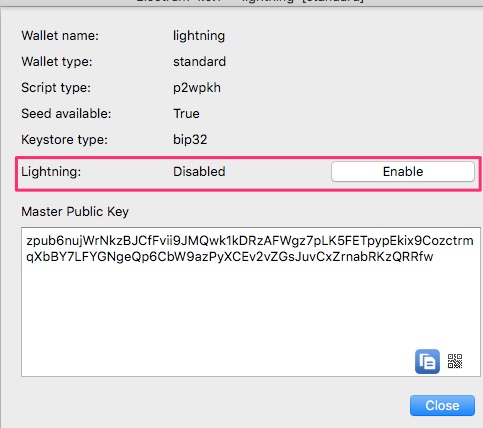
A warning appears, which we confirm.
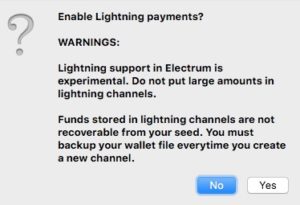
In the first step, we need to load on-chain funds to our wallet. For this we use the Receive function and load at least the equivalent of 200,000sats in the form of bitcoin to the wallet.
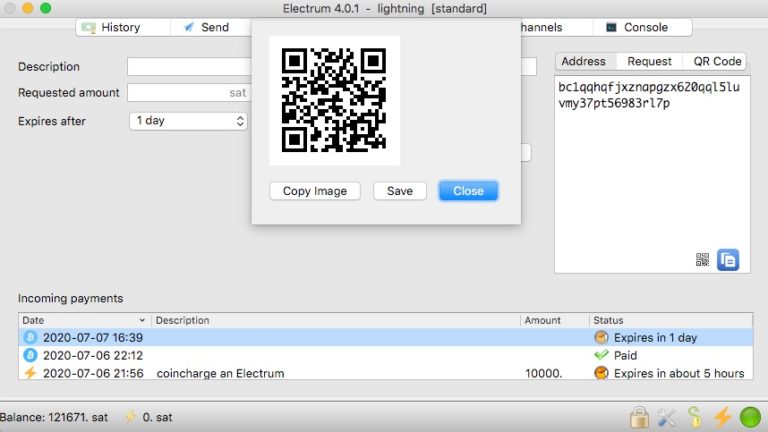
Under History, we see these transactions and have to wait until this transaction has been confirmed on the Blockchain. This can take up to an hour.

If the Bitcoin on-chain transaction is confirmed, then we are able to open a channel to another peer.
We go to the Channels menu item and have the Open Channel function.

If we clicked on Open Channel, we will see our own Node ID (Your Node ID).
Our own node ID can be safely shared with other peers so that they can open a channel to us.
In the Remote Node ID field we enter the node ID of the peer we want to connect to.
We want to connect to the Coincharge node and enter the Coincharge address accordingly:
0318ac9faa9629e7da08819bc8fe0dd2ae3044d69b1b2283a63479acffeb968483@172.81.178.22:9735
Then we are asked in what amount the channel should be filled with liquidity.
The minimum amount is 200,000sats. In the first attempt (see Screen
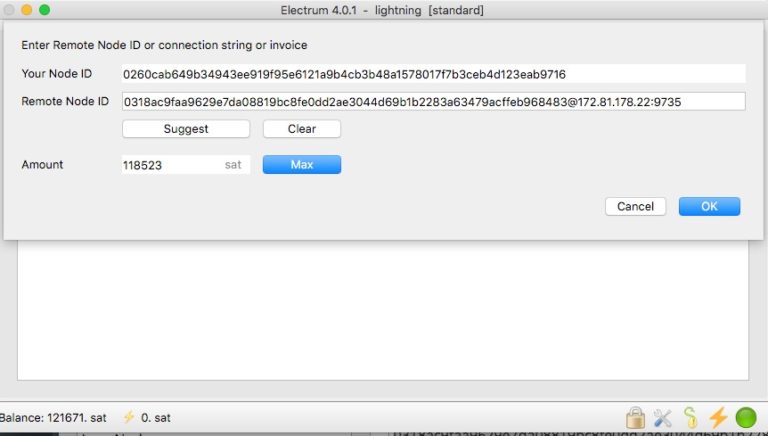
Then only the mining fee will be deducted and we will enter our Electrum Password, which we had set when we set up the Electrum Wallet.
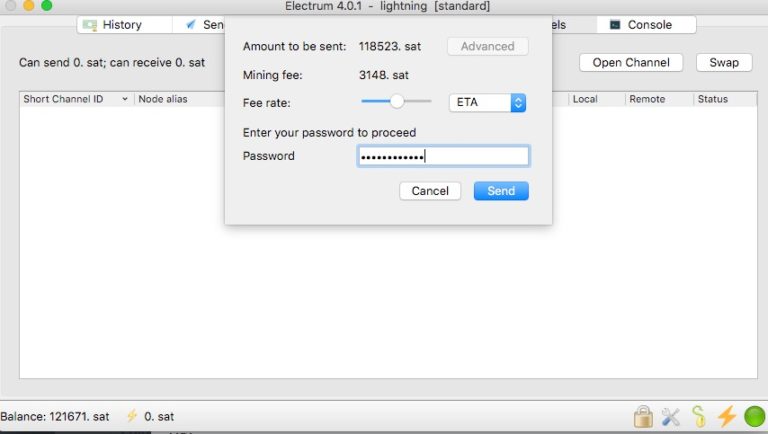
We receive the message that the opening of the channel has started and will be available after 3 confirmations.

In the History section, the channel opening is displayed.

In order to connect one’s own node well within the Lightning network, it is necessary to connect to numerous peers via appropriate channels.
It is also important that there is appropriate liquidity in the channels. This liquidity is required on the Local side if you want to send Lightning payments. If you want to receive Lightning payments yourself, Remote Liquidity is required.
How to obtain the appropriate liquidity is described in the article https://coincharge.io/lightning-liquiditaet/.
After 3 Confirmation, Coincharge has our Electrum peer listed with our Node ID: 0260cab……….eab9716:

The channel is available and Coincharge displays the credit balance as a remote credit balance.
Coincharge opens a channel in the opposite direction for the same amount.

Within the Electrum Wallet there is a possibility to receive remote funds via swap.
Electrum Swap
In the swap method, you send Lightning credits to the swap service provider and receive Bitcoin back. The idea behind this is that when you send Lightning, you build up remote credit. You can increase this remote credit by paying yourself via Lightning or by sending to another peer. So in this case, you send Lightning, increase your remote balance, and get it back in the form of Bitcoin (on-chain), since you don’t spend your Lightning.
This will exchange Lightning credits for Bitcoin credits and receive Remote credits in the process. Remote credit is required to receive Lightning payments.
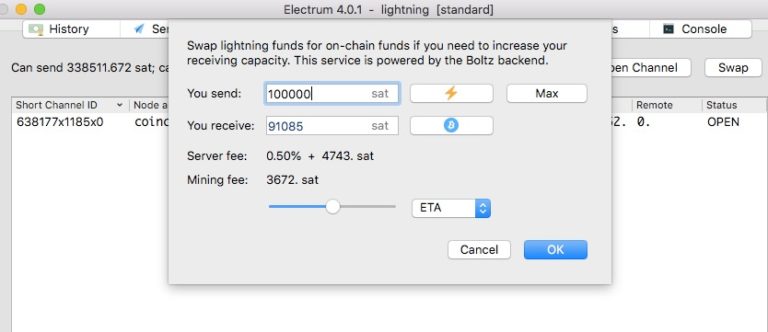
The fee is 0.5 percent of the exchanged volume plus the transaction fee. However, you can also use other services and swap providers to increase your liquidity or remote balance. See the article Lightning Liquidity
Watchtower
If you have opened channels to other peers, these channels have to be checked permanently if there are changes on the channels. If a channel partner closes the channel, then that channel is blocked for 1,000 blocks. This corresponds approximately dr duration of one week. If this channel partner closes the channel with an incorrect amount and no objection is raised within this week, you could lose money.
You should therefore go online with your Electrum Lightning Wallet at least once a week to keep the channels up to date.
We can see in the lower right corner of the display how a synchronization with the Lightning network takes place.
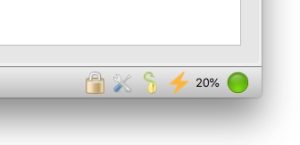
If you do not manage to monitor your channels at regular intervals, you can let a Watchtower take over this task.
This monitoring is carried out by so-called watchtowers. It is important that these channels are monitored because its channel partner could secretly close a channel and report an outdated channel status.
This can be prevented by watchtowers that can monitor the channel and punish the partner for trying to cheat. You can run such a watchtower locally, but this means that you have to keep your computer running permanently. This Watchtower monitoring can also be done by another server. It can be assumed that appropriate service providers will soon be providing this service.
In our case it is not a problem, because we are connected to another peer of ours and therefore a channel closure with a wrong channel amount can be excluded.
To enable a local Watchtower service, we go to Tools and then Electrum Preferences. There we have the Lightning function and there we can activate Watchtower Services.
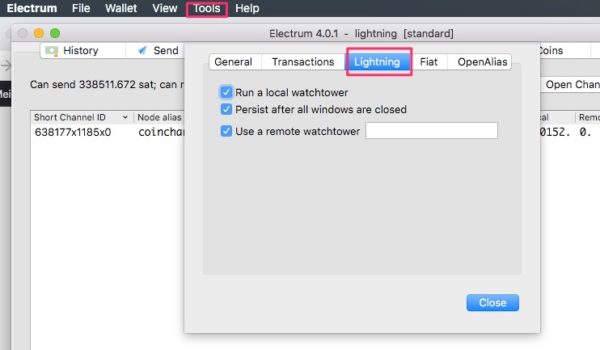
Conclusion
With Electrum, the most popular Bitcoin wallet for the computer also supports Lightning. The handling is so simple and straightforward that you rub your eyes in amazement.
Is everything really available for Lightning here that you would otherwise have to run a separate Lightning Node for?
With Electrum Lightning Wallet, you can send and receive Lightning payments and use all the functions required for Lightning without any restrictions.
The graphics and user interface are typical Electrum style and may take some getting used to for newcomers, but they are 100% functional.
Those who are already familiar with Lightning will quickly find their way around the Electrum Lightning Wallet.
The typical Lightning problem is the connection within the Lightning network and the establishment to other peers with corresponding channels. But if you are well networked and have sufficient remote and local balance, you have a perfect Lightning Wallet that leaves nothing to be desired.
Some points are still unclear to me as well and I would appreciate if readers may be able to help me answer them.
- Since a Lightning Electrum Wallet usually runs on a home computer that is not always online, are there any drawbacks to my Lightning Wallet not always being online?
- Do I need to go online regularly with the Lightning Wallet for the channels to update? Is there a time recommendation, such as at least every 5 days?
- Should I use a Watchtower service and which service can be recommended?
- Is the Electrum Lightning Wallet really like its own Lightning Node?
Happy to receive comments below in the comment box or via Telegramor Twitter.




Leave a Reply
Your email is safe with us.